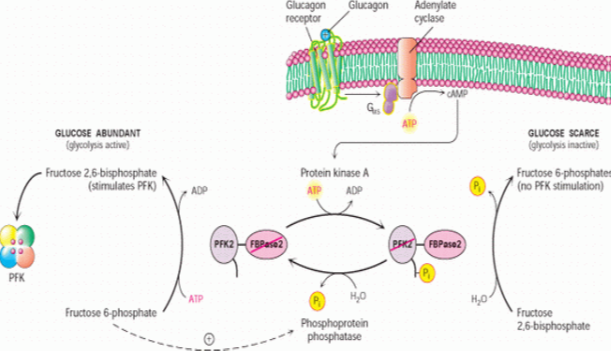Library
Summary of Regulation of Glycolysis
- October 19, 2024
- Posted by: Namrata Chhabra
- Category: Energy metabolism Learning resources Library Metabolism of Carbohydrates Quick Revision Series Quick revisions Quick revisions USMLE Content

Glycolysis is the metabolic pathway that converts glucose into pyruvate, generating ATP and NADH in the process. It occurs in the cytoplasm of cells and is essential for energy production. Glycolysis is regulated at multiple levels to match energy demand with supply.
Modes of Glycolysis Regulation
- Substrate Concentration
- The availability of glucose directly influences the rate of glycolysis. High glucose levels stimulate glycolysis, while low levels reduce its rate. The concentration of intermediates, such as glucose-6-phosphate, also affects the pathway. Hexokinase is inhibited by glucose-6-phosphate.
- Induction and Repression
- The expression of glycolytic enzymes can be increased or decreased in response to hormonal and environmental conditions. For example, insulin induces the transcription of enzymes like glucokinase, phosphofructokinase-1 (PFK-1), and pyruvate kinase, promoting glycolysis. Glucagon and prolonged fasting repress these enzymes, reducing glycolytic activity.
- Allosteric Modification
- Key glycolytic enzymes are regulated by allosteric effectors:
- Phosphofructokinase-1 (PFK-1): Activated by AMP and fructose-2,6-bisphosphate (F2,6BP), signaling low energy and promoting glycolysis. Inhibited by ATP and citrate, which indicate sufficient energy levels.
- Pyruvate kinase: Activated by fructose-1,6-bisphosphate (feedforward activation) and inhibited by ATP and alanine.
- Key glycolytic enzymes are regulated by allosteric effectors:
- Covalent Modification
- Enzymes are regulated by phosphorylation and dephosphorylation. Pyruvate kinase is activated by dephosphorylation (stimulated by insulin) and inactivated by phosphorylation (stimulated by glucagon), adjusting glycolysis according to the energy state.
- Effect of Hypoxia
- Under low oxygen conditions, such as hypoxia, cells rely more heavily on glycolysis to meet energy demands. Hypoxia-inducible factors (HIFs) promote the expression of glycolytic enzymes to enhance the glycolytic flux, compensating for the lack of oxidative phosphorylation.
- Hormonal Regulation
- Insulin stimulates glycolysis by activating key enzymes and increasing the levels of F2,6BP through the activation of PFK-2.
- Glucagon inhibits glycolysis by lowering F2,6BP levels, reducing the activity of PFK-1, and promoting gluconeogenesis during fasting or low-energy states.
- Role of Fructose-2,6-Bisphosphate (F2,6BP)
- F2,6BP is a potent allosteric activator of PFK-1 and a repressor of fructose-1,6-bisphosphatase (gluconeogenesis enzyme). It ensures that glycolysis is favored when glucose is abundant (fed state) and suppressed when energy conservation is needed (fasting)
Conclusion
The regulation of glycolysis is a complex interplay of substrate availability, enzyme induction and repression, allosteric modifications, covalent modifications, responses to hypoxia, and hormonal signals. These mechanisms ensure that glycolysis is tightly controlled, providing energy when needed and preventing wasteful energy production when it is not. Fructose-2,6-bisphosphate plays a central role in balancing glycolysis and gluconeogenesis, acting as a switch between glucose breakdown and glucose production.
